"The
District of Leisure : Bars, Restaurants and Entrepreneurs of the 'Milanesi Navigli'"
The International Journal of Urban Labour and
Leisure, 1(2) <http://www.ijull.co.uk/vol1/2/00007.htm>
| Paola Arrigoni | "The
District of Leisure : Bars, Restaurants and Entrepreneurs of the 'Milanesi Navigli'" |
Introduction.
The aim of the research is to demonstrate the existence and to understand
the functioning of an economical and Marshallian district of leisure placed in a
particular historical area of Milan: the Navigli (leonardian canals).
Studying the elements which give success and leisure appeal to this "Concentration of
specialised industries in particular places " (according to Alfred Marshall's
definition of industrial district) as well as its weakness and limits (principally
environmental and social impact and loss of innovative capacity), the research aims to
enlighten the economical, urban and cultural weight of the leisure district.
The research uses both quantity (census, indicators, attitude scale, multiple-choice
questionnaires to consumers and entrepreneurs) and quality methods (interviews to social
actors, newspaper analysis and participant observation).
The first step consisted in making a census and mapping all the leisure structures of
Milan, to view the main concentrations. This data has been compared with the last urban
transformations (new population such as the city-users and new styles of life or functions
of the city).
The focus was then brought to the specific area of Navigli, adding an accurate historical
reconstruction to the socio-economic survey. Demonstrating the propitious humour of the
place for leisure and socialising activities.
Finally the most conspicuous part of the research concerning the district itself, has been
carried out by:
Milano: Urban Transformations and the Navigli Pubs.
"To be modern means being in a context that promises adventure, power, growth, joy, transformation of us and of the world, and in the mean time threatens to destroy everything we are" (Berman 1985).
Urban transformations from post war years to the 1990s, both
socio-morphological and cultural, have made Milano a city organised in
mono-functionalistic areas and have brought to the constitution of a "modern and
post-Tayloristic" mass consumer society. These changes have created the conditions
for the birth of the district of Navigli.
The principles of accessibility (the distribution of urban resources encourages those
activities able to pay for the opportunity of accessibility to the centre, to the
information, to the potential market) and of agglomeration (growing advantages of scale),
according to Camagni theory, has organized the city; on the one hand marginalizing the
outskirts from the centre and on the other hand creating in the centre many other
specialised areas (financial, commercial, fashion, leisure, sport, university, high class
residence areas).
Our analysis for Milan shows the marginalizing of the outskirts regarding the distribution
of all the structures for leisure (cinemas, theatres, and museums), and particularly bars
and restaurants. Here the imbalance is clear, places like Brera or Navigli in which there
are 17 pubs and restaurants for 1000 habitants, and places like Baggio and Lorenteggio in
which the same ratio goes down to 1:23 (see figure 1).
Figure 1 Distribution of Bars in Milan.
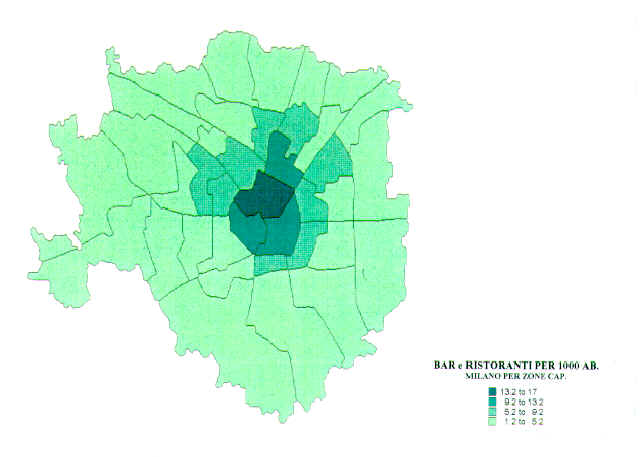
The trend to concentrate this typology of commercial concerns in
'restricted' central areas seems still to be under way. Next to the traditional 'lieux
magiques' of Milanese leisure (Navigli, Brera, Buenos-Aires, Vittorio Emanuele), other
leisure areas such Central station, Ticinese and Moscova are developing.
Recent urban transformations - that according to Martinotti have brought to the formation
of a second generation metropolis, which includes the habitants living out of the city but
linked to it for work or leisure - have obliged us to review the concept of the outskirts,
which are becoming complex, different and sometimes competitive (Della Pergola). But at
least initially, have reinforced the organisation of the city into mono-functionalistic
areas within the historical centre of Milan. In fact these changes extend the market of
the specialized zones to the new metropolitan population, like the city-users,
business men and women who are urban consumers not residents (5 million every year in
Milan). These create induced tourism that is economically desirable. It is not by accident
that our survey indicates that 60% of the Navigli consumers comes from outside Milan.
Pleasant and popular old areas, once populated by marginal people, have become with the
pressure of the consumer's needs, commercial areas with medium-high class residents. The
Ticinese-Navigli area from 1971 to 1991 lost 30.8% of workers, while gaining 12.5% of
entrepreneurs and self-employed people. It is possible that the impact of consumers will
grow, influencing the functionality of the area. At the same time this transformation of
the Navigli area has caused a growth in urban conflict and a loss in the political
interest of the inhabitants. Before the integration among residents, city-users and
leisure's organisers were strong. It was usual to find in a private yard and a place for
dancing or playing bowls. Now that the old social tissue has been expelled in favour of
the trendy pubs, this has caused conflict between residents and tradespeople.
On the other hand, the modern mass consumer society generates a process, which after the
loss of social points of reference linking humans to both the place of work and to the
community relationship, the mass-person is born. The 'jobs' do not give identity and
sociality, therefore consumers try to compensate by substituting leisure for it. But the
industry of leisure aims at taking possession and ruling this 'free' leisure time making
it equivalent to working time, with the means of fashion, contributing to the diffusion of
hetero-directed behaviours.
The hetero-directed behaviour is characterised by a low attitude to initiative,
responsibility and creativity. These deficiencies are encouraged by a system in which
"time tends to loose its quality of resource and becomes more and more a product
instead of a factor of production" (Savelli 1984).
Hetero-directed people are motivated by the needs of sociality, escapism and their
expression for consumer leisure as well as sharing with others the same anxiety, anomy and
isolation generated by modern society. However, the difference is that hetero-directed
motivations are experienced in an artificial context, created and managed by institutions.
"Institutions manipulate man through desires with an action that takes a coercive dimension. The phenomenon we are interested in is the intentional expropriation of motivations, degradation of individual patterns and their substitution with collective proposals and patterns, set up by the industry of leisure." (Riesman 1990).
The hetero-directed tends to confuse working time and leisure time, until
they become unrecognisable.
The characteristics and the needs induced by the society in which we live, concerns both
the entrepreneurs and the consumers of the district. A common vision of interests emerges,
so that the consumers share some points of the "district culture" peculiar to
the entrepreneurs:
- The same need of sociality and defence or affirmation of their own personality, denied by the working world;
- The importance of leisure dimension, both like profession and like object of consumption to give back loss of identities;
- A certain satisfaction for the typologies of the bars and restaurants as they are.
In Milan there is almost nothing except the traditional areas for leisure
like the Navigli or Brera and this is an explanation of their continuous success. In the
last few years some new places responding to the needs of auto-directed consumers have
opened, such as alternative pubs that copy community centres or those, that are going to
commercialise and institutionalise themselves, like their Swiss and Dutch colleagues.1
Those new kind of demands and supplies testifies the complexity of the behaviour and
consumption's models and the large range of possibilities. This permits the formation of
subcultures and ways of not being conventional near to the tendency "to make
euphorically assimilated to an ideal medium man the most different contents" (Morin
1963). However this phenomenon is only in the beginning phase and involves a minority of
consumers who momentarily do not have the force to condition the supply.
The History of the Leisure District and of its Innovative Elements.
"Isn't it true that every suburb catches up its climax just a little before the end of its construction? After this its planet describes a curve, becomes close to the trading (...). Until the street is new enough, belongs to common people and get free of them until fashion starts smiling at her. Then, no matter how much it costs, the interested fight for having buildings and flats. (...) They start to reduce the yards, some of them are eliminated too, until when a New years day comes in which it is in bad taste having such an address on a visiting card. Most of the habitants in fact are shoppers" Lefeuve (1873).
"La mode est la recerche toujour vaine, souvent ridicule, parfois dangereuse, d'une beautè superieure ideale." (Balzac)
"In Paris, in 1757, there were just three cafés".
The degree of district activity innovation and structuring can be used in
an analytic way to identify four different historical epochs.
To understand this, we introduce a Doppia Entrata table, which represents the history of
the district of the leisure.
History of the District of Leisure in Navigli Milanesi.
| Organisation structure: absent | Organisation structure: present | |
| Innovation: low | Pre-existence of propitious humus in Ticinese | Maturation (and decline?) of the district |
| Innovation: high | Formation of the district | Structuring of the district |
At the moment the Ticinese district is seen as the leading actor. It is a
suburb with a historically popular and extra-legal composition (it was called "the
kasbah"). Ticinese is traditionally a leisure district: the tradition of Milanese
pubs is high and related to the history of the Darsena, the second port of Italy until the
1920s after the port of Genoa. The incubation area of the district was situated between
XXIV Palace and the San Lorenzo columns and in fact in the beginning of 1970s, some
members of Lotta Continua, an extra-parliamentarian group, bought some bars
in the district transforming them into modern bars for evening use. The press called these
bars "Le Operette", a name borrowed from the first bar born in the district:
"L'Osteria dell'Operetta" to be precise. Following 'The Operette's' example,
other members of the parliament left and bought up many bars at low prices in the Navigli
district. A political-cultural element was added to the popular aspect of the old pubs. It
was a time of complex transformation of the old pubs into the modern where political
discussions, began in political seats, lasting until dawn. In a district that until the
late 1970s was the area for the major concentration of political seats in Europe.
The second period began, between the years of 1979 to 1982 (see figure 2)2,
brought to the birth and new development the modern district of leisure. This history is
connected to the end of the season of political engagement and with the grafting of the
spiral of terrorist violence. In fact with the demobilisation of the left movement in the
1970s, there was a progressive and exponential growth of bars and restaurants in the
Navigli district. Many of the leaders of Lotta Continua, Avanguardia
Operaia, Movimento Lavoratori per il Socialismo recycled themselves into
para-cultural sectors, transforming themselves into entrepreneurs of 'leisure'. We can see
this recycling as a commercial continuum in the way of doing politics in the 1970s. In
fact many of these bars have continued to be the reference point for informal social
gatherings, selling with the beer a special product: "The lost feeling of political
seats". Becoming entrepreneurs, these people were able to interpret changes in act,
and to find the elements of innovation and of profitability. They reacted to the
socio-political change using it as an opportunity to introduce new styles of life and for
free time use.
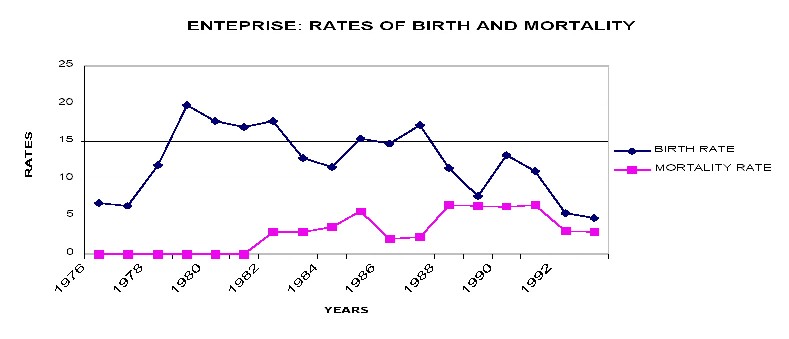
The following three possibilities were origins of innovation:
The change inside the sector of free time;
The socio-demographic change;
The emerging of new ways of perception and styles of life
These three dimensions were tightly linked to the ones below and it is possible to identify the connection between them:
The importance of consumption and styles of life linked to the search of the definition of the identity in free time,
The shift of the demographic gravity centred towards the young people,
The change of values: necessity for self-expression, hedonism, and absolute freedom of expression in longer leisure hours and clothes, also wanting informal environments for live music, commanding a low price social lifestyle.
The retirement after the political season of engagement during the 1970s and the necessity for new spaces and forms of aggregations for the coming of the "sweet nothing" season of the 1980s.
To those social changes the entrepreneurs of the stillborn district
replied brilliantly. They re-presented the leisure of the Milanese as avant-garde. These
bars and restaurants offered a new brand of leisure such as informal ways with the
customers, low prices, later closing times, e.g. 2 am or 3 am, high quality multiple
entertainers playing live jazz and blues music, and 100s of different kinds of tea or rice
with the possibility of eating throughout the night. Their own young customers were
innovative and constituted as a sort of live furniture (like for example the punks in the
1970s that were openly visually stimulating and attracted consumers to gawp, they
constituted an element of the attraction in itself).
The third period between 1983-1989, in which the district consolidated its first
enterprise, receiving a flow of new entries and developing an organisational structure.
The birth of the spontaneous form of collaboration amongst some pubs and entrepreneurs is
the evidence of this attempt to find organisation.
On the other hand the laissez-faire attitude of the public administrators in
favour of bars and restaurants in the matter of noise and occupation of public soil and
water (flowerpots on the streets and floating boats on the canals) caused anger amongst
the residents. The inhabitants later organised their own Committee.
Between 1985 and 1989 a second wave of bars and restaurants opened. The new entrepreneurs
were passive imitators of the old entrepreneurs' success and reaped easy earnings. They
contributed to the loss of originality of the district. Only some young entrepreneurs
'such as cooks' that opened high level restaurants maintained a certain grade of
innovation.
The last period from 1989 to the present has completed the maturation of the
district, also bringing some signs of decline. The number of bars and restaurants has been
growing again but has stabilised at a certain level without exploring its peak, because
there are higher barriers to entry to the market.
The innovative motion already feasible for the leisure supply now involves entrepreneurial
associations unable to take new challenges, divided inside, entrepreneurs focus more on
decor than on innovation. The chronic problems of parking, traffic limited zones, the
'ordinary' maintenance of the suburb and the regulations for obtaining shop licenses are
problems that needs to be addressed with almost immediate attention and resolved but at
present there is no visible political will to do so.
Responsible for this suffocating situation, besides the district's associations, is the
absence of public administration. When the public administration makes an attempt at
intervening it is ambiguous and without a general project.
The Marshiallian District.
Now along the canals of the Navigli, you find pub after pub, while quickly all the
other kinds of shops and commercial concerns, except antique shops are disappearing. The
area is becoming a big 'nightly entertainment park'.
The Marshallian district meaning "a concentration of specialized industries in
particular place" (Marshall 1959) has been proved by the following elements:
A concentration of almost 100 bars and restaurants in few streets, increased by 500 per cent in twenty years;
Presence of valorisation economies due to the historical and architectonic appeal of the area;
Importance of urbanisation economies (great potential of city's market);
Birth in the 1990s of stronger barriers to entry to the market as well as of two Associations of categories;
Organisation of the district based on Informal economic mechanisms such as family and friendship relations or "moonlighting";
The presence of a common district culture, that even if responsible for some lack in service culture and in the eco-esthetical re-qualification of the area, can reorient innovatively the district's activities through entrepreneurs with open minds and their organizational skills.
The district of leisure: day and night images
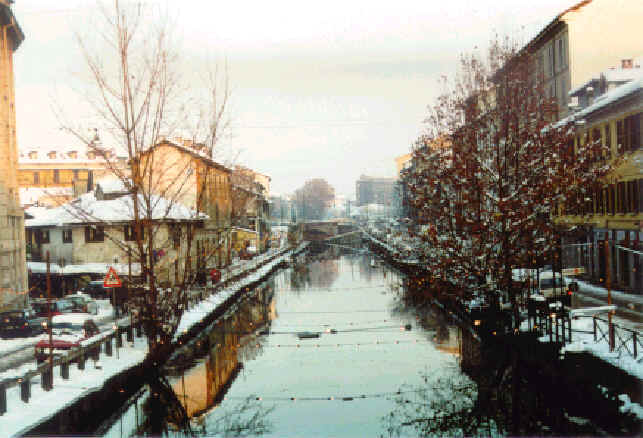
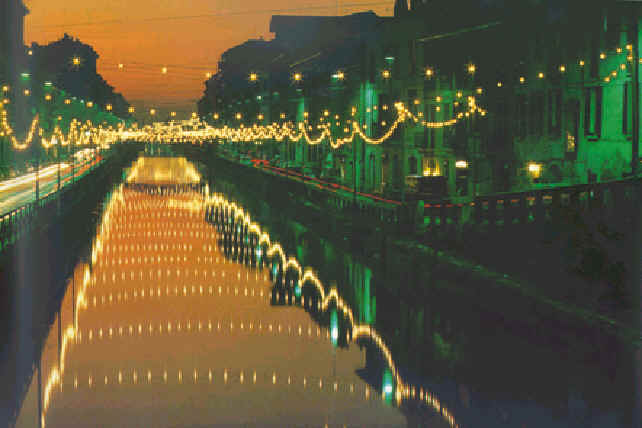
Aesthetical and Functional Typology of Bars and Restaurants: The Navigli Appeal.
"Fashion is helpful for trading but not for societies, creativity and mind" (Fraser Kennedy)
From an aesthetical and functional point of view, the atmospheric
characteristics of the area, influences in a decisive way each single commercial concern,
so that the customer who chooses its place, does not look for 'a specific pub', but 'goes
to the Navigli', where by on walking around will enter in a pub of his choice in that
moment.
The zone is characterized by:
- The presence of many typical navigli houses of the XVIII and XIX centuries called case di ringhiera (railing houses)
- The artificial canals from the 1200's with the sluices by Leonardo da Vinci and the old bridges made of iron and steel
- Rustic ancient wash houses made of stone and wood
- Suggestive out-of-the-way-bits and important monuments such as S. Cristoforo's church.
All the elements permitting, in an urban context that constantly renews
its building patrimony to recognize the Navigli suburb like a "piece of authentic
Milan" with a strong identity, able to act as a great appealing factor.
The urban context of "streets of waters" is now made instrumental for commercial
aims. The Suburb-village once always animated is now sadly deserted during the day because
its streets have been transformed into an avenue for evening promenades.
The building characteristics of the zone conditions bars and restaurants dimensions:
Long and narrow pubs
Most has one-room only
A limited number of doors or windows on the streets (2-3).

Bars and restaurants are not very different from each
other but represent a variation on the same theme (same lists, same insignia, same
sponsors for the sunshades that in summer cover the sidewalks).
To "classify" aesthetically, bars and restaurants, we utilised classic
categories the modern3, the old style milanese pub and the period
furniture4. The old milanese pub doesn't exist anymore, so we have
created two under-categories, from the intersection of modern style with the period style
of old milanese pub, calling them artefact or cloned old milanese pub5
and mutant or contaminated old milanese pubs6. Weak categories
that we are obliged to use because not one of the pubs has a real strong aesthetical and
functional environment.
The conclusion is that while the mutated and cloned old Milanese pubs are dominant
and the period pubs discretely present, modern styles are almost absent. Unfortunately
modern styles are the one's more easily original and innovative.
Organizing Structure : Enterprise and Associations.
Around the Darsena, the Naviglio Grande and Pavese, there is a concentration of 89
small and medium sized enterprises specialised in recreation and "free time".
However similar (for example in each of them eating is possible) the premises show
variations on the theme of leisure supply. So there are Italian restaurants, ethnic,
pizzerie, wine bars, bierkellers, old style pubs, disco-bars, karaoke and live music
clubs. The percentage weight of the nightclubs with a specific function of restoration is
45%. Among the remaining 55% bars:
- 30% offer leisure supply not alimentary
Of this 30%, 22% consists of live music (22%).
Typology of Bars and Restaurants.
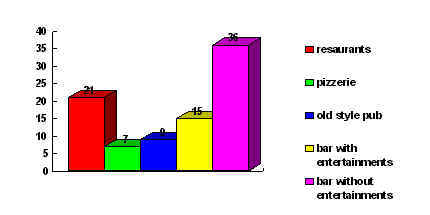
Geographically there's a strong presence of restaurants and old style
pubs (osterie) on the Naviglio Grande and bierkellers and bars on the Naviglio Pavese that
also has younger customers.
Entertainment Supply.7
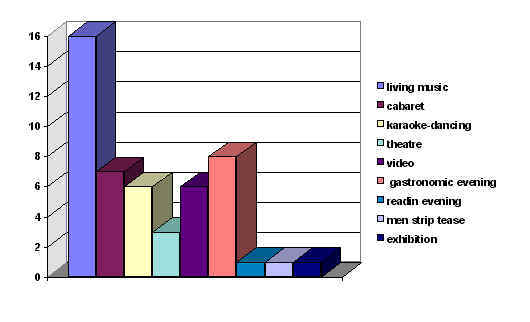
The principal ruling mechanisms of the commercial activities of the district, except the market, are that belonging to the informal economy:
Reciprocity mechanisms, that involves families and entrepreneurs friends in relations not merely funded on business;
Toleration of "moonlighting", that means tax evasion. This evasion originated by low administrative and penal control could be considered as a form of indirect support from the Institutions to the enterprises. They belong to those political mechanisms of the ruling economy that eliminate ties to the market and instead of modifying it, go along with it.
All these mechanisms perfectly harmonise themselves with the little family
enterprises, predominant in the district (49% of cases).
In these little dimension enterprises, family is important for the following reasons:
Family is often the first financial source that permits to open the pubs
and can help in case of necessity.
The other original reciprocity mechanism operating in the district is that connected to
friendship, often due to the common existential political pattern, that links some
entrepreneurs among them and with a part of the customers. This implies: -that in some
pubs, some customers don't pay or have special discounts; -some pubs were born like
co-operative with informal shifts regarding vacation and working hours; - spontaneous
collaborations and easy mobilisation in defence of their primary interests among the
entrepreneurs who are friends
Enterprise Property.
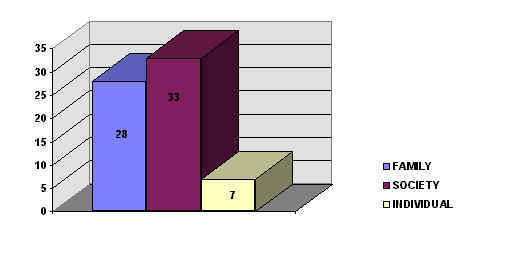
Next to these 'informal' mechanisms, there is an attempt to set up a
'formal' organisation, by co-ordinating and promoting activities of different enterprises
through associations, that are acting as collective actors, assume decisions, take
initiatives and be the speaker towards public administration, local authorities and other
private subjects. Associations involves about 60% of the entrepreneurs of evening leisure
and restoration (the more younger and the more educated), includes antique dealers,
painters and other shoppers.
There are two structures one for each Naviglio: the Naviglio Grande Association, existing
from 1982 and the Navigli Oggi Association, from 1985. In this period there is a project
underway concerning the formation of a unique association 'pub-orientated'.
The Naviglio Grande Association, has good intentions but no decision making power, and is
essentially 'predatory' towards the external environment, seen as a means of earning. This
association has great acting power because the administration sometimes tolerates and
permits violation of the law.
The other Association (Navigli oggi) is fluctuating between the 'predatory' type and the
'good intentioned' one. Good intentioned Association means the one who thinks of projects
for re-qualification in culture, ecological and leisure fields but that does not have the
normative strength that only Institutions can provide.
Association Tipology
| Institution attitude laissez-faire |
Institutions attitude Intervention |
|
| Associated motivation Gain |
A Predatory association |
C "Guided" association |
| Associated motivation Re-qualification |
B good intentioned association |
D innovative association |
The Entrepreneurs and the District Culture.
"What a litter!" From a group of seven friends came: two extra parliamentary groups, a manager, a prestigious lawer, a novelist and You. And the one? The man with the glasses. You didn't tell me his name…" (Montalban 1993).
"Once you were monkeys; even today the man is the "monkiest" of all the monkeys." (Nietzsche).
All of the entrepreneurs share a district culture, which approaches them to consumers. Constitutive elements of this humus (typical of the tradesmen) are:
- The charm of lifestyle linked to the leisure profession;
- Calvinistic working rhythms;
- Optimism about the future;
- A good image of their clubs;
- Constructive Criticism about Ticinese degradation, institution fugitiveness and the association's incapacities to ecological and cultural re-qualification;
- The same ideas for necessary operations to improve the district;
- The incapacity to really operate and innovate.
The innovation rate of entrepreneurs comes from an index, which shows not a really comfortable situation. 65% of trade shops has been found only on a sufficient level of score, while the remnant 35% is above it. This is to say that the measurement was very severe but such a severity is necessary for a town like Milan. Both the younger entrepreneurs and those who have just started their activities are more inclined towards change. It seems strange but the graduates are less inclined to innovation maybe because most of them belong to a class of entrepreneur imitators and semi-innovators.
| Score | Degree of innovation | Number of cases | % |
| 7-10 | Low (scarso) | 24 | 35 |
| 11-14 | Just sufficient ll(sufficiente) | 34 | 50 |
| 15-18 | Reasonable (discreto) | 10 | 15 |
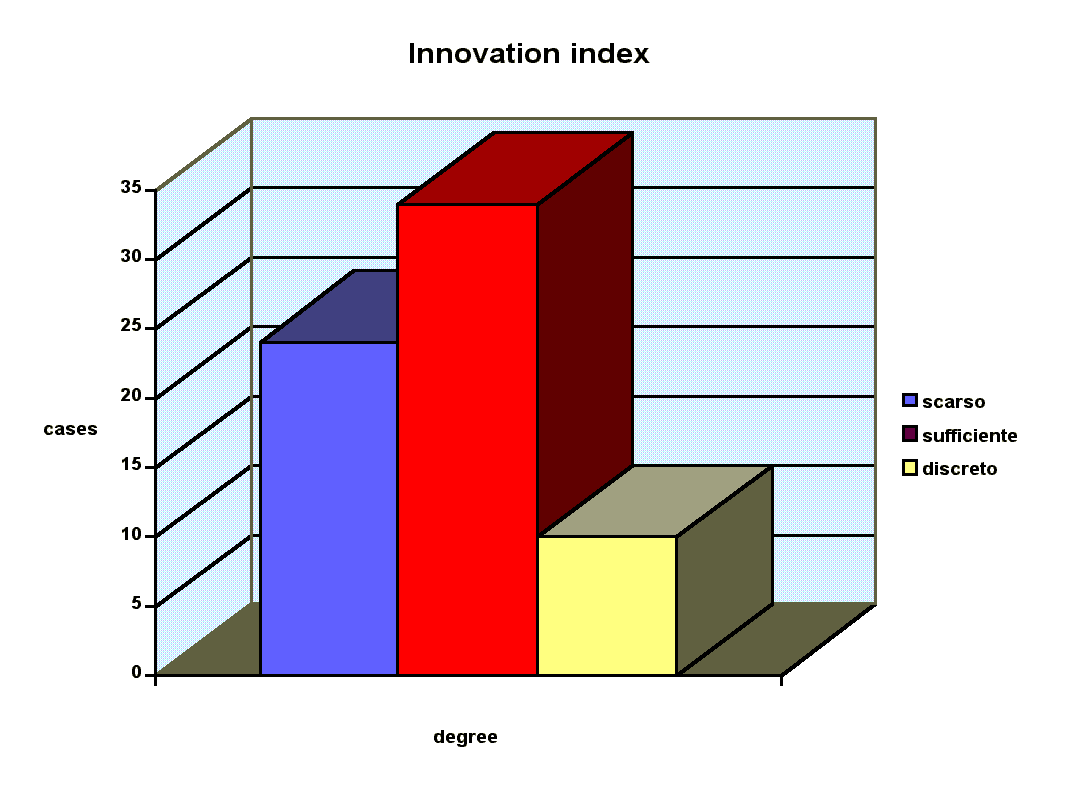
We have created, thanks to a double entry table, an entrepreneurs typology based on differences.
| innovation I : high | innovation II : low | |
| motivation I : fuga-autoexpression | Animated innovatory entrentrepreneurradical-chic styletype of clubs: jazz-club and osterias | Semi-imitator entrepreneurSpoilt-enjoyment styletype of clubs: karaoke-disco/bar-pubs in style |
| motivation II :profit-prestige | semi-innovator entrepreneurrefined cuisine styletype of clubs:luxury restaurants | imitator entrepreneurnew fashioning styletype of clubs:evening osterias and music clubs |
The first dimension, following the Schumpeter (1971) classic model, is the
rate of capacity and desire to innovate "high or low".
The second is the motivation linked to the auto-expression here understood as an escape
from dependent/routine jobs and a necessary sphere for ones own creativity. It can also be
oriented to profit and/or prestige which such a profession gives and it derives from a
'literature' upon a society of wide consumption.
From these dimensions derive four different types of entrepreneurs whom manage different
bars and restaurants.
| 1) | The district builders who come from movements of the new Italian political left make the first typology. Principally their bars and restaurants are jazz clubs, music-pubs and the readapted osterias, which follow the modern taste. The management style is radical chic; they are ex employers now rich but not insensitive to socio-political problems. They analyse these problems in a free way and they operate in an informal and open manner. |
The Other three types of typologies belongs to the second 'entrepreneur's generation', which uses more or less innovate discoveries from the first generation.
| 2) | The district builders who come from movements of the new Italian political left make the first typology. Principally their bars and restaurants are jazz clubs, music-pubs and the readapted osterias, which follow the modern taste. The management style is radical chic; they are ex employers now rich but not insensitive to socio-political problems. They analyse these problems in a free way and they operate in an informal and open manner. |
| 3) | The semi-innovative entrepreneur who has operated between the 80's and the 90's is an educated young entrepreneur who decides to open in a nice and historical district like the Navigli, a "medium-high cuisine restaurant" supported by his high cooking and his charming manners. He decides to utilise the district attraction to put in something that has never been in it before. The style is that of a refined and Amphitryon chef who likes talking with his clients between courses to increment prestige and fame. |
| 4) | The semi-imitating entrepreneur is young and he generally comes from a rich family. He uses his relatives' money to open fashion bars and restaurants like karaoke, pubs and disco-bars. In this way he escapes from hetero-directed jobs seen as a mental alienation. These are "baby" entrepreneurs, they do their job and defend their interests but for them very important is the enjoyment dimension. For this they are more similar to consumers than entrepreneurs. |
| 5) | The imitator is motivated by gain, which a district of amusement offers, and he is a perfect free rider in it, he offers any news and improvements. Here the family dimension is important in the management too. His style of life is that of a new arrival who goes up on the social scale and follows all forms of dominant values created by fashion. |
It is interesting to note a connection between imitator or semi-imitator
entrepreneurs and 'predatory' association, which generates them.
The Customers.
"Tell me what you eat and I will tell you who you are". (Brillat-Savarin 1985)
For Navigli customers the typology depends on:
a) Type of motivation (escape - auto-expression; integration-belonging to community)
b) way of auto-direction and hetero-direction behaviour).
Both these dimensions are linked to 'modern' consumption society.
So we can note different types of consumers: 1970s nostalgic consumer; habitual consumer;
'specialised' consumer; searching consumer; searching and anomic consumer;
anomic-integrated consumer and the working consumer.
| autodirected behaviour | heterodirected behaviour | |
| motivation I : integration/belonging to community | A1 1970s nostalgic consumer A2 habitual consumer | C working consumer |
| motivation II :autoexpression/escape | B1 refined-specialised consumer B2 anomic consumer and or searching consumer | D anomic consumer |
The A consumers frequent the Navigli for
emotional reasons. They are forty-fifty year old people who, in some ways, participated in
the 60s and 70s political movements. They come here to look for some old friends to talk
with about the country political and social status or about common friends. They normally
frequent the same bars and restaurants of 'ex-comrades'. They form a little community used
by them as a source of personal identity (nostalgic consumer) Beside these there are also
younger consumers do not link to a particular historical or political period, they
frequent these bars and restaurants with a foolish artistic ambition (sometimes
improvising with a guitar) or they are friends of regular consumers or friends of owners,
they simply live there! All of these constituted a sort of live furniture for the clubs
(habitual consumer). It is not a case that bars and restaurants that they frequent are the
same of the '68s nostalgic consumers': but for the same informal atmosphere caused by the
manager's origin.
The B1 consumer searches hours of 'intelligent' enjoyment. They are a 'specialised
consumer' integrated into the society where he lives, pleased by his position at work.
S/he does not live for the necessity of more free time, which rewards them from
frustrations, but likes some cultural consumption to reinforce their identity and to
assure them about their 'very good position' and their critical capacity. In fact they
never choose common clubs or popular shows, they goes to Navigli because they wants a
club, that plays particular music and they want to eat a particular dish.
The B2 consumer does not want to follow the mainstream system because they do not like a
pattern. They can have a strong personality and values but they search for better ways to
express them. They impose margins to their creativity and inventions: searching consumer.
But they can also be on an anxious search without strong references and be an anomic and
searching consumer. Their way of undecided and fragile operation is determined by the
'crash of moral community' so as Durkheim called it, so fails the normative system, the
values which had given clear directives of existence and in spite of they discover a
greater freedom, at the same time their uncertainty grows. They could arrive: where it is
possible to find a strong and original identity, where people are simply searching
consumers, where it is possible to fail into 'ecstasy' depression (understood as an escape
in strong and extreme emotions and in the artificial empathy to excel rational
difficulties) becoming an integrated anomic, where you must put up with the system, ending
the research and becoming a dissatisfied working consumer; in each cases they move
themself towards other consumer typologies. Of course it is possible not to change and
this is the more frequent result.
In each case the B2 consumer is able to auto-direct themself, and this fact removes them
from fashion inducted by industries of free time. So if they choose to go to Navigli they
will lean toward something specific, for example a blues or jazz concert of an artist not
very known to the public. However their emotions take them towards other leisure places so
this makes it is possible to say that they are not a usual consumer in the district.
The anomic-integrated consumer type D in the table is dissatisfied about things but he
does anything to change them or himself, he chooses an easy escape that doesn't change the
status quo. They search 'not a relief from tension but the exact contrary: a specific type
of tension, a form of excitement connected with fear, sadness and a lot of other emotion
which everybody keeps away from in every day life' (Elias & Dunning 1989)
The consumption of ecstasy in the discos nowadays is nearly a common practice amongst
younger like the "joint" seven or eight years ago, it is an extreme consumption
so exemplary to describe this sort of consumers. We are not saying that all of those who
belong to this category are ecstasy consumers, but the type of needs and the manner to
search them are very similar.
From a research made by the A.A.S.Ter society in 1994 among discos in the north-east of
Italy (Lombardia e Veneto: Como, Brescia, Cremona, Mantova, Verona, Vicenza) results that
the 80-85% of the interviewers often used ecstasy and in the most of the cases on Saturday
and Sunday evenings. The use of the ecstasy is strictly connected with enjoyment, with
"lived time" to cut out in a very shot space in a very intense manner.
These necessities are strictly connected with the very strong need for "social
status" denied by the productive rules. Obviously ecstasy gives that "temporary
state of conscience alteration" which served to create such need. It appears evident
the connection between the use of ecstasy and the working condition of post-Ford worker.
It is also evident that the places like discos, "after hour", "raves"
where the ecstasy is principally used are linked to the new musical tendency (Moroni 1996)
The typical D consumer has a job, which does not give identity and social status and
chooses temporary modalities for enjoyment, lived in a very intensive manner because it is
rewarding. On the other hand they give to official structures or operators the possibility
to organise their social lives and for their need to enjoy themselves, this happens in a
functional way for the status quo. In fact after having their extreme enjoyment these very
good people return to their "honest jobs".
This type of consumer is in the Navigli too. It is principally represented by numerous
younger who often come from Bergamo, Brescia and Como (joined by the Milanesi) who does
this journey predominantly on Fridays and Saturdays to go to deafening clubs and exit
dulled by alcohol and onto another club of the similar kind, but far from the first one,
to stay until the morning.
Satisfied working consumer (type C): He is the integrate one that also in the free time
wants to demonstrate that he is like the others, he belongs to this big tribe and in a way
he continues to work even during leisure time in a rule created for him by the system. A
system that he does not want to disappoint. "The structure of rules and values in the
industrial working world, where the top aim is production, finds an application in free
time too. This free time, considered and emphasised as a reward for the job, is very
sinchroniced with the principle of higher efficiency and to the rule of
increasing productivity … He is very careful about his free time …
The measure of free time is constantly pushed up by the consumption competition showed in
society … This production consists in the consumption of immaterial perceptions and
products. Tha act of consumption belongs to his experience and learning field, but does
not modify deeply the subject and nature of his needs, because requirement of measuring
each other in the index of the rendering of time keeps him linked to a quantitative
character and stops the qualitative modification of the relation sphere"
(Savelli 1984)
This type is a bit of a Toeffler presumption, he deals with "terrible"
sacrifices to obtain his little piece of homogeneous free time: - queues; - traffic; -
noise; - and pays to be insulted "for jokes", in bars and restaurants like
"La parolaccia" in Rome. This type of clubs does not exist in the Milanese Latin
District of Navigli, but most of the consumers which come to this district are very
similar to working consumer who are always in search of famous bars and restaurants to be
able to say "I was there".
The conclusion is that the customers are principally hetero-directed and as if Elias
(1988) thinks "To be civilised means to operate with a real intention having to aim
for reasonable needs, so we are civil when we have a "constant reflexive capacity
prevision, capacity in calculation, auto-control, precise and articulate self-control of
the effects of our actions" (Elias). Then the consumers presumed or
anomic-integrating behaviour which is dominant in the Navigli consumers, who live in a
continuous state of unsatisfactory regarding the 'always' new material products, who do
not think about their life but blindly follow models of behaviour and habits kept without
any critical thought, it confirms a sort of incivility of the free time in the district.
This incivility in part is shared by those entrepreneurs-consumers who open bars and
restaurants without any projects, they only want to continue to play, consuming amusements
and living a life of integrate always 'getting-away'.
Future Patterns.
Once demonstrated that the district exists and after having studied in an
analytical way the actors, the organisation and the problems, it seems suitable
'remembering what we have said,' to do some considerations about these bars and
restaurants future.
The history of the constitutive elements of the amusement and entrepreneurs of the
district, leads us towards the conclusion that the Navigli presents lots of innovative
elements, whose strength has been so big that in spite of the 80's the Navigli began to
loose the capacity to innovate themselves or to create newness, still today is a landmark
for Milanese free time.
In this position they are helped by Milan which is on a low level of innovative ideas in
the amusement field; and by prevailing hetero-directed behaviours of the customers who do
not know how to ask or only to imagine better things and they just enjoy themselves with
'streets of water' walking with the sensation to be able to choose between many
alternatives. In search, after the trouble to find a parking, of a club where it is
possible to socialise or to find again a part of their own fragile identity, because jobs
do not return it.
It is very interesting to understand the reasons of the Navigli success when we consider
the desolating conclusion made by us concerning the innovation for entrepreneurs,
associations and esthetical functionality bars and restaurants or imagining the future
scenery of Milanese leisure.
It seems that bars and restaurants and the entrepreneurs have two possibilities: - doing
nothing, continuing to transform the degraded plastic funny play for children-adults who
live in an uncivilly way in their recreation time. In this context to live uncivilly has
the Finkelstein meaning, in a hetero-directed way full of simulated needs created by
fashion, and constantly in search of something impossible to find in the Navigli's social
life and culture. Maybe this happens because of the poor creativity in Milan. The other
solution is to operate in a constructed way both in the ecological and cultural field,
pressing the institution with serious and good projects to begin a solid collaboration
between private and public. So they create some problems for competitors who begin to open
'private-social' bars and restaurants along the State railways, and also live the euphoria
of still being the new leisure model, giving themselves a 'clear' commercial future.
The choice of this second option would make it necessary to find solutions which meet the
individual demands of all the participants, starting from the principal elements of
weakness in the recreational area as pointed out:
- The existence of a high level of conflict amongst the entrepreneurs, inhabitants, consumers and establishments.
- The lowering of the amount of innovation both with regard to recreational offer and to the aesthetic / functional types of premises.
- Urban and environmental degradation due to the lack of car parks, bad road conditions, noise, and the absence of normal maintenance and planning to make the district more liveable and enjoyable.
If these are the main problems linked to the area, what action should be
taken and with the aid of which instruments? The key words are:
Communication, Innovation, Quality.
COMMUNICATION:
Signifies understanding the need to create relationships and promote discussion amongst the entrepreneurs, inhabitants, various establishments and consumers in order to define a shared strategy. Working on decisions with an upward momentum, as hoped for/specified in the Local Agenda 21.
Communicate: How? Open forum.
An open forum is one of the most successful methodologies to solve conflicts
and favour endogenous/interior local development based on the evaluation of local
resources and responsibilities in the area. The Forum foresees the participation of the
main public and private participants in the recreational area, who would be organised into
groups to work on the themes of urban community in relation to the recreational
establishments (the theme of community is to be understood both as a promotion against
social degradation and as an improvement of environmental and urban degradation) and on
the role of recreational establishments as regards cultural and recreational benefit. The
activities of the work groups will be co-ordinated by national and international experts,
who will co-ordinate and moderate the meetings in order to aid the decisional process.
INNOVATION The introduction of new products both in terms of recreational and cultural benefit and in terms of aesthetic/functional planning of the establishments, and also in terms of communication and promotion.
Innovate? How? Networking and awards
By promoting networking activities with the exchange of
knowledge among various European countries, studying the successful cases of innovation in
the field of recreational activity and in the management of the difficulties caused by
recent urban transformations.
By organising training courses, perhaps distance learning courses directed towards the
entrepreneurs in the recreational and cultural sector, also in collaboration with other
European countries.
By implementing an annual prize for the most innovative establishment from the point of
view of recreational benefit, of aesthetic typology and of management. The competition
would take place initially on a local basis, but subsequently it could be extended to a
wider horizon (regional, national, European).
QUALITY: The improvement of the production process: from the client's own knowledge, to the protection of the environment, and finally to the safety of the workers and consumers.
Quality: How? Integrated Quality Management
Application of a management programme and of a quality plan
integrated into the establishments. The integrated management system allows the following
benefits to be obtained:
Externally: reducing the impact on the environment and improving the welcome, the safety
and the service offered to clients.
Internally: rationalising working conditions and reducing management costs.
The actors of this ecological-recreative re-conversion project of Navigli (not only
entrepreneurs, but also institutions, consumers and residents) must decide if they want to
accept this challenge without hesitation, that according to Berman, "promises
adventure, power, growth, joy, transformation of us and of the world, and in the same time
threatens to destroy everything we are " (Berman 1985). The challenge is high, we are
not sure if the multitude of entrepreneurs will leave their certainty to begin the big
travel of change.
Notes.
1) Riportiamo solo quest'esempio di nuova offerta di leisure perché ci sembra il più macroscopico sia per diffusione che qualitativamente, non ignorando che esistono altre modalità nuove e interessanti di fruizione dello svago, ma più limitate nel senso detto.
2) Le scansioni temporali utilizzate per inquadrare la storia del district sono state scelte osservando la serie storica ricavata dai dati ufficiali della Camera di Commercio, che si trova nel primo paragrafo del quarto capitolo di questa ricerca
3) Modern is what answers to technologies and taste of our time
4) Period is the absorption of an already existing object (American bar, decò bar)
5) Cloned old milanese pub (cloned osteria), is an osteria, which tries to recreate using furniture and atmosphere, the idea, the flavour of a real old osteria.
6) Mutant old Milanese pub (mutant osteria) is the osteria that changes some elements of the original adding some modern elements in furniture or to the typologies of leisure supply.
Bibliography
Balzac Du Camp, Paris, VI, p.294.
Berman, M. (1985) L'esperienza della modernità, Feltrinelli.
Brillat-Savarin. (1985) Fisiologia del Gusto. Rizzoli (prima ed. 1895)
Camagni, R. (1992) Economia urbana : principi e modelli teorici. NIS
Elias, N. (1988) Il processo di civilizzazione. il Mulino.
Elias, N. opera citata nella nota 28
Elias & Dunning (1989) Sport e aggressività. il Mulino.
fonte: vedi nota n. 9
Lefeuve, (1873) Les Anciennes Maisons de Paris Sous Napoleon III.
Marshall, A. (1959) Principi di economia. UTET (prima ed. 1920)
Martinotti, G. (1993) La Nuova Morfologia Della Città. Il Mulino.
Montalban, M.V. (1993) La Solitudine del Manager. Feltrinelli.
Morin, E. (1963) L'Industria Culturale. Il Mulino.
Moroni, P. (1996) Ma l'ecstasy è una droga-fordista ?, AASTER.
Nietzsche, F. Citazione da cui Prende Nome il locale Le Scimmie .
Riesman, D. (1990) La Folla Solitaria. Mondadori.
Savelli, A. (1984) Sociologia del Turismo. Angeli.
Schumpeter, J.A. (1971) Teoria Dello Sviluppo Economico. Sansoni.
Paola Arrigoni
(Vimercate –Milano- 1969) Sociologist, expert in the field of regional development. She is currently working in a socio-economic research institute called ISPO (Studies on the public opinion). Co-founder of the '89 Studies Centre', a multidisciplinary group (philosophy, art, sociology, biology, etc,) whose goal is the cultural growth of the Milanese civil society and the promotion of the entrepreneurial mentality among the young and the disadvantage groups. In the recent past she has been working for ACTA (Association for culture, tourism and environment) that gathers experts in the field of sustainable tourism and regional planning and has collaborated with the Milanese Superior Institute of Sociology. Email: paola.arri@libero.it
|
|
|
![]()
| © 1999-2000 International Journal of Urban Labour and Leisure |